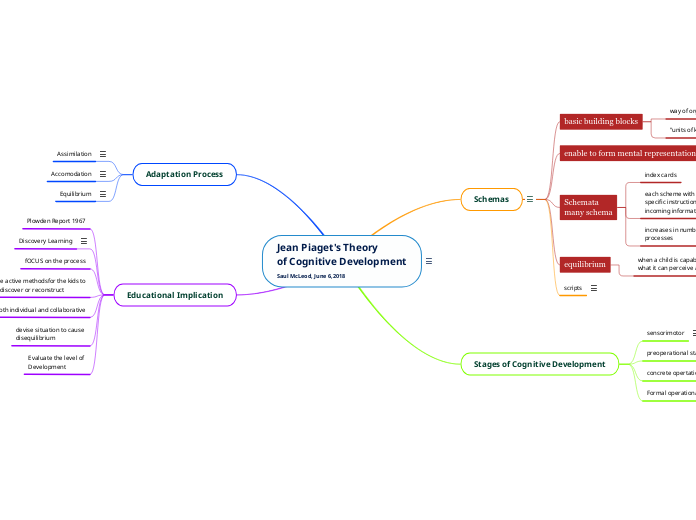a Taniela Seruvatu 3 éve
585
Jean Piaget's Theory of Cognitive Development Saul McLeod, June 6,2018

a Taniela Seruvatu 3 éve
585

Még több ilyen
1. It is concerned with children, rather than all learners.
2. It focuses on development, rather than learning per se, so it does not
address learning of information or specific behaviors.
3. It proposes discrete stages of development, marked by qualitative
differences, rather than a gradual increase in number and complexity
of behaviors, concepts, ideas, etc.
The goal of the theory is to explain the mechanisms and processes by which
the infant, and then the child, develops into an individual who can reason and
think using hypotheses.
To Piaget, cognitive development was a progressive reorganization of mental
processes as a result of biological maturation and environmental experience.
Children construct an understanding of the world around them, then
experience discrepancies between what they already know and what they
discover in their environment.
the idea that children learn best through doing and
actively exploring - was seen as central to the transformation of the primary
school curriculum.
'The report's recurring themes are individual learning, flexibility in the
curriculum, the centrality of play in children's learning, the use of the
environment, learning by discovery and the importance of the evaluation of
children's progress - teachers should 'not assume that only what is measurable
is valuable.'
Because Piaget's theory is based upon biological maturation and stages, the
notion of 'readiness' is important. Readiness concerns when certain
information or concepts should be taught. According to Piaget's theory
children should not be taught certain concepts until they have reached the
appropriate stage of cognitive development.
According to Piaget (1958), assimilation and accommodation require an active
learner, not a passive one, because problem-solving skills cannot be taught,
they must be discovered.
This is the force that moves development along.
Piaget believed that cognitive development did not progress at a steady rate, but rather in leaps and bounds.
Equilibrium occurs when a child's schemas can deal with most new information through assimilation. However, an unpleasant state of disequilibrium occurs when new information cannot be fitted into existing schemas (assimilation).
Equilibration is the force which drives the learning process as we do not like to
be frustrated and will seek to restore balance by mastering the new challenge
(accommodation). Once the new information is acquired the process of
assimilation with the new schema will continue until the next time we need to
make an adjustment to it.
existing schema ( knowledge)doesn't work and needs to be changed to deal with
a new object or situation
using an existing schema to deal with a new object or situation
The formal operational stage begins at approximately age eleven and lasts
into adulthood.
During this time, people develop the ability to think about abstract
concepts, and logically test hypotheses.
Piaget considered the concrete stage a major turning point in the child's
cognitive development because it marks the beginning of logical
or operational thought.
This means the child can work things out internally in their head (rather
than physically try things out in the real world).
Children can conserve number (age 6), mass (age 7), and weight (age 9).
Conservation is the understanding that something stays the same in
quantity even though its appearance changes
During this stage, young children can think about things symbolically. This
is the ability to make one thing - a word or an object - stand for something
other than itself.
Thinking is still egocentric, and the infant has difficulty taking the viewpoint
of others.
The main achievement during this stage is object permanence - knowing
that an object still exists, even if it is hidden.
It requires the ability to form a mental representation (i.e., a schema) of the
object.
"a cohesive, repeatable action sequence possessing component
actions that are tightly interconnected and governed by a core
meaning." ( Piaget, 1952, p.7)
defined as " a set of linked mental representation of the world"
which we used to
For example, a person might have a schema about buying a meal in a
restaurant. The schema is a stored form of the pattern of behavior which
includes looking at a menu, ordering food, eating it and paying the bill. This is
an example of a type of schema called a 'script.' Whenever they are in a restaurant, they retrieve this schema from memory and apply it to the
situation.